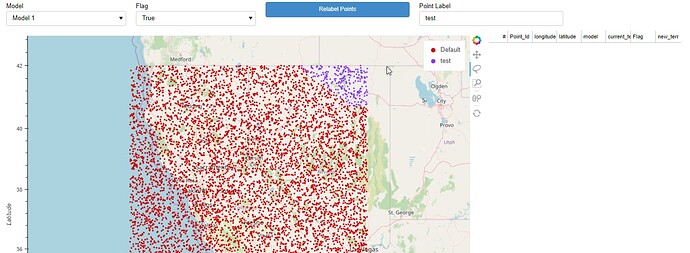I have ~10k points on a map, and I want to be able to select a subset, and change a label on them (e.g. a territory assignment) and then have the map update to reflect those changes (on a button press, for instance).
I tried using dynamic maps and a parameterized dict to store the territory assignments. It mostly works, but it is very, very slow to update, and sometimes the button push just fails to fire (maybe the previous events weren’t complete?). I suspect my issue relates to the fact that I am altering a pandas dataframe and re-loading all the points from there… it would probably be faster to alter the gv.Points set in-place?
Anyone have time to tinker with this example and make suggestions?
import geopandas as gpd
import pandas as pd
import geoviews as gv
import holoviews as hv
import panel as pn
from cartopy import crs
from holoviews.streams import param
from shapely.geometry import Point
import random
gv.extension('bokeh')
hv.renderer('bokeh').webgl = True
#records to generate
n = 10000
#bounding box
min_lng = -125
max_lng = -115
min_lat = 32
max_lat = 42
#generate 10,000 points in a bounding box
records = []
for point_id in range(0,n):
records.append({'Point_Id':point_id,
'longitude':random.uniform(min_lng,max_lng),
'latitude':random.uniform(min_lat,max_lat)})
test_df = pd.DataFrame.from_records(records)
#split into sample sets; we want to be able to label points in any combination of model/flag independently
df_list = []
model_sets = ['Model 1','Model 2',]
flag_sets = ['True','False']
for m in model_sets:
for f in flag_sets:
temp_df = test_df.copy()
temp_df.loc[:,'model'] = m
temp_df.loc[:,'current_terr'] = 'Default'
temp_df.loc[:,'Flag'] = f
df_list.append(temp_df)
permutation_df = pd.concat(df_list,sort=False)
#convert to geodataframe
permutation_df.loc[:,'geom'] = permutation_df.apply(lambda r:Point(r['longitude'],r['latitude']),axis=1)
test_gdf = gpd.GeoDataFrame(data=permutation_df,crs='EPSG:4326',geometry = permutation_df['geom'] )
test_gdf.to_crs('EPSG:3857',inplace=True)
del test_gdf['geom']
#Widgets
model_pick = pn.widgets.Select(options=model_sets,
name='Model',
value=model_sets[0],
width=250,
disabled=False)
flag_pick = pn.widgets.Select(options=flag_sets,
name='Flag',
value=flag_sets[0],
width=250,
disabled=False)
text_input = pn.widgets.TextInput(name='Point Label', placeholder='Reviewed')
# button to push relabeling event
remap_points_button = pn.widgets.Button(name='Relabel Points', button_type='primary')
remap_points_button.on_click(callback = lambda event: push_point_updates(event=event,
index=point_sel.index,
table=plot_points,
model=model_pick.value,
flag=flag_pick.value,
new_label=text_input.value))
class TerrMapper(param.Parameterized):
'''
stores map of point (including model & flag context) to label
'''
terr_map = param.Dict(doc = 'mapping dictionary for points-->territories, by context')
#instance with defaults
terr_map = test_gdf.groupby(['Point_Id','model','Flag']).agg({'current_terr':lambda x:list(x)[0]}).to_dict()['current_terr']
terr_mapper = TerrMapper(terr_map=terr_map)
@pn.depends(terr_map=terr_mapper.param.terr_map,watch=True)
def base_point_func(terr_map):
'''
build the base point object with territory labels from the terr_map dict
'''
# map the 'new_terr' column based on current state of the terr_map dict (this may be the slow part; how can we label in-place on the points objects rather than re-drawing them all?)
test_gdf.loc[:,'new_terr'] = test_gdf.apply(lambda x:terr_map[(x['Point_Id'],x['model'],x['Flag'])],axis=1)
base_points = gv.Points(data=test_gdf,vdims=['Point_Id','new_terr','model','Flag'],crs=crs.GOOGLE_MERCATOR)
return base_points.opts(height=800,width=1000,color='new_terr',cmap='glasbey',show_legend=True)
def dyn_points(base_points,model,flag):
'''
subset of points to be visible based on picklist choices
'''
model_points = base_points.select(model=model,Flag=flag)
return model_points
base_points = hv.DynamicMap(base_point_func,streams=dict(terr_map=terr_mapper.param.terr_map))
plot_points = base_points.apply(dyn_points,model=model_pick.param.value,flag=flag_pick.param.value)
point_sel = hv.streams.Selection1D(source=plot_points)
@pn.depends(index=point_sel.param.index)
def sel_table(index):
'''
for inspecting selected point values metadata
'''
filtered_table = plot_points[()].data.iloc[index,:]
out_cols = [c for c in filtered_table.columns if c!='geometry']
#not_nulls = filtered_table[()].data.iloc[index,:]
return hv.Table(filtered_table[out_cols])
def push_point_updates(event,index,table,model,flag,new_label):
'''
update terr_map with new territory labels for selected points
'''
Point_Id_list = list(table[()].data.iloc[index]['Point_Id'].values[:])
temp_dict = terr_mapper.terr_map.copy()
for Point_Id in Point_Id_list:
temp_dict[(Point_Id,model,flag)] = new_label
terr_mapper.param.set_param(terr_map=temp_dict)
base_points.event(terr_map=temp_dict)
#Plots
hv_table = hv.DynamicMap(sel_table)
pn_test = gv.tile_sources.OSM() * plot_points.opts(tools=['lasso_select'])
layout = pn.Column(pn.Row(model_pick,flag_pick,remap_points_button,text_input),pn.Row(pn_test,hv_table))
layout
example of UI after a re-labelling event:
